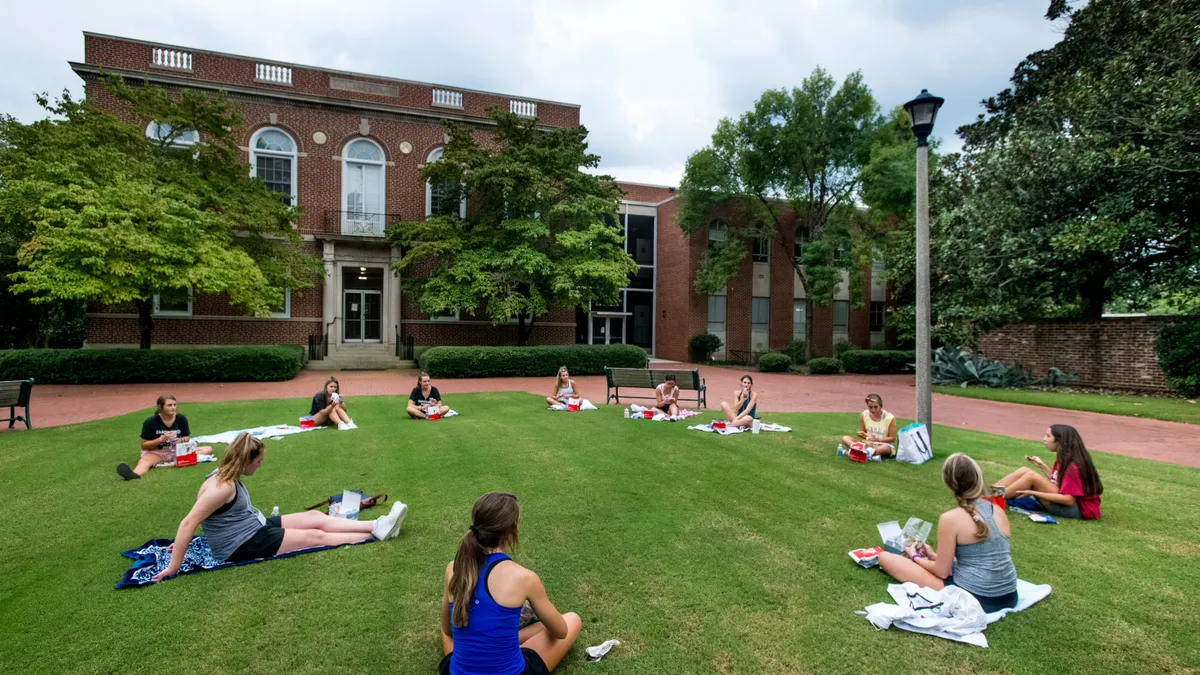Dive Brief:
- High school students are more likely to attend college if they think their families can afford to send them, according to new research released Wednesday by the National Center for Education Statistics.
- Just 38% of 11th graders who didn't think their families could afford to send them to college were enrolled in postsecondary education three years after their scheduled graduation, according to NCES. By comparison, 58% of students who thought their families could afford to send them to college were enrolled.
- Similar trends could be seen in whether students had ever attended college. Three years after high school, 80% of students who'd said their families could afford to send them to college had in fact attended at some point. Only 59% of those who didn't think their families could afford college had ever attended.
Dive Insight:
The latest data from NCES adds depth to a fact researchers and the higher education sector have long known: Characteristics like family socioeconomic status are closely related to whether a student ends up going to college. Generally speaking, students whose parents attained higher levels of education and who come from wealthier families are more likely to enroll in college themselves.
But the new research doesn't just show that the reality of a family's financial situation affects whether a student will attend college. It indicates that perceived college affordability often becomes enrollment reality.
That's not surprising to higher ed policy experts and researchers. But the finding is nonetheless important because the data confirms what they often see on the ground, they said.
"I think it's generally what we expect and know from work qualitatively," said Michele Streeter, associate director of policy and advocacy at The Institute for College Access & Success, which pushes for affordability and equity in higher ed. "It's an unfortunate byproduct of not only the actual cost burden, but also the psychological burden and the narrative and rhetoric that are in the air over the past decade or so."
Making college more affordable for students would help to address the gaps in attendance, Streeter said. To that end, The Institute for College Access & Success has pushed efforts like doubling the maximum size of the Pell Grant for low-income students. Other changes, some of which will be implemented under a 2020 law overhauling federal student aid and the Free Application for Federal Student Aid, could target students' perceived affordability by making it easier for them to predict whether they'll qualify for Pell Grants, Streeter said.
Evidence also indicates telling students early about financial aid options can affect whether they enroll in college, Streeter said.
Telling high school seniors about college costs and resources available to offset them is acting too late, according to Michelle Miller-Adams, a political science professor at Grand Valley State University in Michigan. As a result, college access programs try to engage families early in their K-12 years. But many high-poverty school districts are short on resources like school counselors, Miller-Adams said in an email.
Advocates of tuition-free college programs, like New York State's Excelsior Scholarship or College Promise programs, have sometimes argued that the messaging of free college is critically important. As the argument goes, the idea of attending college without paying tuition is broad, attention-grabbing and attractive. It can make more students believe they can attend, boosting applications and eventually enrollment.
"This is one of the strongest rationales for College Promise programs — they tend to serve as catalysts for school districts (even those serving large concentrations of low-income, first-generation college-goers) to start talking about college and possible post-secondary paths earlier," wrote Miller-Adams, who has published a book about tuition-free college programs.
The NCES research looked at data from students enrolled in 9th grade in 2009. Students were surveyed between 2009 and 2016. Their college transcripts were collected in 2017-18.
Over 23,000 students participated in the study. It is nationally representative of 9th graders in 2009 and includes students who attended public and private schools across the country.
When most of the surveyed students were in 11th grade, 32% indicated their families couldn't afford to send them to college, even if they were accepted.
Students most likely to have attended college three years after high school were those who believed their families could afford to send them and who had at least one parent who'd attained a bachelor's degree or other college degree — 90% of those students had ever attended college at that point.
Those least likely to have attended college three years out from high school were those who did not think their families could afford to send them and whose parents also had a high school diploma or less. Just 55% of this group had attended.
Working while not attending college three years after high school was more common for students who didn't think their families could afford to send them to college than it was for those who did, 43% versus 32%. But more of the former group weren't in either college or the workforce, 20% versus 10%.
Views of college affordability can impact enrollment, employment rates
Whether a student believes they can afford to go to college could affect how they seek information, NCES Commissioner Peggy Carr said in a statement. That includes information about paying for college or whether to apply at all.
"College affordability is a major concern for families, and paying for college looms large for students, particularly students who would be the first in their families to earn a degree," Carr said.
NCES examined college attendance and employment status three years after high school because that year, 2016, was the most recent point at which the cohort's members were surveyed.














